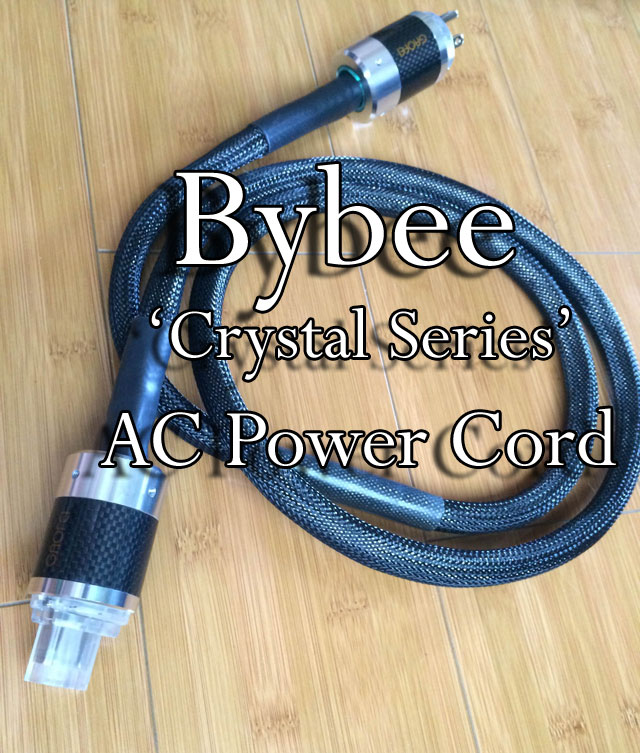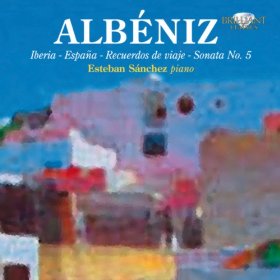Bybee Crystal Series AC powercord

 I’ve been through this before. You think you’re sitting pretty with some really great sounding AC powercords, then another brand or model comes along. You hook it up, maybe not expecting all that much, but it surprises you; it sounds really good and that prodigal homunculus audiophile inside your skull whispers that you can’t possibly live without it.Till the next innovative AC cord comes along and it all starts over again.
I’ve been through this before. You think you’re sitting pretty with some really great sounding AC powercords, then another brand or model comes along. You hook it up, maybe not expecting all that much, but it surprises you; it sounds really good and that prodigal homunculus audiophile inside your skull whispers that you can’t possibly live without it.Till the next innovative AC cord comes along and it all starts over again.
Whether you’d regard my system as entry, middling, or low-high-end level (a valuation that has a lot to do with your income bracket), the fact is, excluding loudspeakers, the biggest improvements in the sound of this system have resulted from changing AC power cords. Makes me reflect again on the many years I regarded the AC powercord imbroglio as flimflam and wishful hearing, an area of audiophile reportage that needed a hefty dose of good old double-blind testing.
Jack Bybee’s latest power cord is an exception to this pattern only in the unprecedented degree of improvement it provides. The enhancement of ambient, inner-voice and micro-tone retrieval, of definition, articulation, bass—as well as their dead silence—have proven very favorable in comparisons with much pricier AC cords, including one costing over five times as much.
In this age of quanta ex nihilo it may not be safe to assume that ‘electron flow’ in a given 6’ pair of copper wires—that wire’s ability to deliver high current instantaneously—is going to be essentially the same regardless of wire configuration; so that audible differences must be attributed to other factors. Nonetheless I tend to make that assumption. In the case of the Bybee, that “other factor” is a thin plastic proprietary material they call simply “Stuff”. In the case of the LessLoss Signatures that the Bybees replaced, that other factor is chemical compounds deposited directly on the copper. The changes we actually hear with either of these cords is a result of cleaner electricity. They do not change the sound of your gear, they enable your gear to operate closer to their peak.
The LessLoss treatment has essentially no effect whatsoever (any more than would a resistor wired in parallel with a conductor) until frequencies become high enough for skin effect to kick in. At high frequencies (noise), eddy currents become strong enough to push the primary current flow (traveling in the opposite direction) away from the axis of the conductor toward the skin, where proprietary chemical deposits dissipate it as heat.
The Bybee Crystal Series AC cord works differently. Jack Bybee, a physicist whose working career is in quantum electrodynamics, generously spent the better part of an hour on the telephone, trying to explain it to me. A lot of it was simply over my head. I’d be kidding myself if I imagined I understood much beyond the basic goal of providing a clearer path for electromagnetic force to do its stuff. On the face of it LessLoss aims at reducing externally induced noise, Bybee aims at reducing internal, molecular noise, although the effect of creating a “quieter” pathway on the quantum level may affect induced noise as well. The evidence of my ears is that the Bybee Crystal Series AC cord is at least as quiet as the LessLoss cord and, as implied by the greater amount of musical information it delivers, provides significantly “cleaner” electricity.
The “stuff” developed by Bybee contains “crystal-like” materials that are activated by electromagnetism and have the uncanny ability to affect the alignment of protons in specific proximal atoms. Based on this ‘old fashioned’ model of the atom, such an alignment results in the nucleus having the properties of a bar magnet. This in turn results in an “easier” (more stable) path for EMF and therefore a reduction of the deleterious effects of capacitive and inductive reactance as well as molecular noise. If the components of an unaligned nucleus, protons and neutrons, churn about producing continuously fluctuating magnetic poles, it is easy to conceive that an array of fixed-pole nuclei will provide a consistent and predictable path for the passage of charged particles, as well as exerting a profound influence on the behavior of electrons in the “orbit” of the nucleus. Or something like that. Jack Bybee was careful to point out that his description, on which this speculation is based, was only an hypothesis; what I’ve written is several times removed from that.
We may not know the precise physical events taking place in a copper wire surrounded by nucleus-sized magnets in proximity to an electrical current, but the effect of a magnetic field on electrons is demonstrable. I first discovered it as a kid holding a permanent magnet up to a CRT television screen. This, I expect, is the same basic principle used to concentrate and accelerate charged particles in the Large Hadron Collider at CERN. I suspect that as far as audiophile AC powercords go, we are seeing only the beginnings of this technology.
The three 12 AWG conductors in the Bybee cord are flexible because they are made of many fine oxygen-free copper strands. These conductors are insulated with PVC rather than a material with better permittivity, like Teflon, for a very particular reason: PVC is a carbon-based compound, therefore statistically 1.1% of its carbon atoms are 13C, a stable isotope of carbon. This is wrapped in a layer of Bybee “stuff.” And the interaction of these two materials is where the magic happens: in the presence of “stuff,” 13C protons align into a stable polarity, they become magnets. All of this is inside an EPTFE tube, an expanded (and expensive) form of Teflon insulation that is custom made to Bybee’s specifications. This in turn is inside a woven copper shield, which is inside a woven black nylon serving.
I was curious why Bybee used OFC copper rather than the top-notch OCC copper commonly found in audiophile AC powercords. The answer was refreshingly simple and direct: Bybee tried OCC and it didn’t sound any better than OFC. I did not ask how many 9’s—how pure—the copper is. Because I’ve been informed by a well-known manufacturer that anything beyond two decimal places is the brain child of marketing departments.
Jack mentioned High Fidelity Cables, that have a patented design that does something similar in principle to his AC cords, using an arrangement of permanent magnets and a special alloy wire that can conduct a magnetic field. Their CT-1 line of AC powercords range from the Ultimate at $6,900 to the Ultimate Reference Rhodium at $12,900 (reviewed here by Norm Luttbeg). The new Bybee Crystal Series AC cords retails for $1,500.
I’ve been able to discover very little about the Gaofei CFR50/50M connectors used on the Bybee cord. They are designed in the USA, are presumably manufactured in China, and are clearly of superior quality, sleeves of milled aluminum bar stock, carbon fiber shielded, with solid copper, rhodium-plated pins.
The Gaofeis are not as expensive as the Oyaide 079s used on the LessLoss Signature, but that may be due to advertising, exchange rates and labor cost differences, more than differences in quality. The Oyaide has phosphorous bronze pins machined from bar stock, two layers of gold plating, and are mounted in glass-filled, rock-like polybutylene terephthalate. The Gaofei’s pins are mounted in a clear polymer that could be polycarbonate. I do not know if they are machined from bar stock or stamped from sheet stock. I do understand the reasoning behind these meticulous manufacturing procedures (retaining crystal structure, improving contact area, minimizing micro-arcing). I was pleased to note that the grip of the Gaofei IEC is every bit as strong as that of the Oyaide. Both Oyaide and Gaofei plugs are aesthetically pleasing, though I prefer the austere look of the aluminum and carbon fiber Gaofei over the transparent red polycarbonate Oyaide.
Japanese manufacturers like Oyaide and Acoustic Revive stress minimizing sensitivity to vibration. However I think damping AC plugs is less critical than damping wire—there is so much more of it. It is a fact that stiff, hard objects take longer to dissipate mechanical energy than flexible, soft objects. In this regard, Bybee’s very flexible wire has a definite advantage. I reckon damping is fairly easy to measure and quantify but I have never seen any concrete data from any manufacturer, of any device, at any price point. It would be useful to have objective evidence to support subjective experience with different cable materials, insulators, connectors, suspension devices, etc.
My system consists of a transport, DAC and a pair of monoblocks: four AC powercords. The widely traveled cords that Bybee ships to reviewers are as in demand as hotdogs at a church social, so after waiting some weeks, I received my allotted two instead of the four I would have liked. As instructed by Jack Bybee (and seconded by our stalwart publisher, Clement Perry) I installed the Bybee Crystal Series AC cords on the monoblocks; the transport and DAC retain LessLoss Reference AC cords. As a long time Tiefenbrunian I was somewhat surprised at this instruction, but it’s been a very long time since turntables ruled the front end. I recall reading somewhere that Bybee favors placing noise reduction devices as close as possible to the loudspeaker drivers. In his system, the two AC cords he currently has on hand are connected to his monoblocks.
 Isaac Albénez: Iberia, Recuerdos de Viaje, La Vega, et al; Esteban Sánchez, piano (Brilliant Classics 92398). We are extremely fortunate to have these performances, originally recorded in Barcelona between 1968 and 1974—Franco was alive and Spain was fascist. It was my brother, that doyen of recorded classical music, who turned me on to this pianist. When Daniel Barenboim discovered Estaban Sanchez’s Iberia, he said, “How is this possible? How can Spain have hidden away a performer of such class?”When I first heard Esteban SánchezI was impressed by the intensity and freedom of his playing, I knew I was on to something special, a pianistic spirit outside my prior experience. He plays with a consuming passion, perhaps more importantly, he approaches performance with an intense seriousness. He is that rarity for whom music making could be described as a matter of life and death.
Isaac Albénez: Iberia, Recuerdos de Viaje, La Vega, et al; Esteban Sánchez, piano (Brilliant Classics 92398). We are extremely fortunate to have these performances, originally recorded in Barcelona between 1968 and 1974—Franco was alive and Spain was fascist. It was my brother, that doyen of recorded classical music, who turned me on to this pianist. When Daniel Barenboim discovered Estaban Sanchez’s Iberia, he said, “How is this possible? How can Spain have hidden away a performer of such class?”When I first heard Esteban SánchezI was impressed by the intensity and freedom of his playing, I knew I was on to something special, a pianistic spirit outside my prior experience. He plays with a consuming passion, perhaps more importantly, he approaches performance with an intense seriousness. He is that rarity for whom music making could be described as a matter of life and death.
Unfortunately, neither the instrument nor the recording are on a par with the playing. The Bybee Crystal Series AC cords cannot alter this fact, but it goes a long way toward solving the problem. I’ve noticed this before doing AC powercord reviews: greater ambient detail gives to the soundgreater sense of presence, and this can considerably compensate a recording’s shortcomings. In addition, the Bybee Crystal Series AC cords seems to provide a fuller and truer tonal center. This recording is transformed from rather poor quality to merely somewhat idiosyncratic. It is much more listenable. It is much more beautiful. It engages and involves, it draws me into the music.
 J.S. Bach: The Well Tempered Clavier, Book II; Wanda Landowska, Pleyel harpsichord (RCA 7825-2-RC). Now, you can take it from me—someone who has tried to love this set of CDs for decades—that something remarkable is happening. There is no question that one of the motivations of the audiophile is enhanced appreciation of the music; expensive equipment is not just for impressing the neighbors and decimating the bank account. But can one’s appreciation of particular music, of a particular performance, really alter because of a change in AC powercords? You mightn’t think so, but the fact is, yes it can. Let me backtrack a bit. The musicologists tell us that book two of Das Wohltemperierte Clavier is superior, more spiritually profound, etc., than book one. I don’t doubt it, but I’ve never responded to it that way. I’ve heard two or three versions and I’ve always found it a sluggish journey through occasionally tedious terrain, especially in company with Landowska’s damnable Pleyel combined with the inferior quality of the recording. I’ve noted in prior review show a certain components improved this situation, enabled me to listen without setting my teeth on edge. But the effect of using the two Bybee Crystal Series AC cords is extraordinary. I do not expect my hyperbole to be believed, but there it is: a glorious old recording of an instrument that, after all, has its own unique beauty. I was able to appreciate the music more than ever. I do not exaggerate in saying Jack Bybee’s AC cords have opened up a rich seam of gold in my CD collection.
J.S. Bach: The Well Tempered Clavier, Book II; Wanda Landowska, Pleyel harpsichord (RCA 7825-2-RC). Now, you can take it from me—someone who has tried to love this set of CDs for decades—that something remarkable is happening. There is no question that one of the motivations of the audiophile is enhanced appreciation of the music; expensive equipment is not just for impressing the neighbors and decimating the bank account. But can one’s appreciation of particular music, of a particular performance, really alter because of a change in AC powercords? You mightn’t think so, but the fact is, yes it can. Let me backtrack a bit. The musicologists tell us that book two of Das Wohltemperierte Clavier is superior, more spiritually profound, etc., than book one. I don’t doubt it, but I’ve never responded to it that way. I’ve heard two or three versions and I’ve always found it a sluggish journey through occasionally tedious terrain, especially in company with Landowska’s damnable Pleyel combined with the inferior quality of the recording. I’ve noted in prior review show a certain components improved this situation, enabled me to listen without setting my teeth on edge. But the effect of using the two Bybee Crystal Series AC cords is extraordinary. I do not expect my hyperbole to be believed, but there it is: a glorious old recording of an instrument that, after all, has its own unique beauty. I was able to appreciate the music more than ever. I do not exaggerate in saying Jack Bybee’s AC cords have opened up a rich seam of gold in my CD collection.
Clifford Jordan Quartet: Live at Ethell’s (Mapleshade 56292). I can imagine you exclaiming, Doesn’t this guy own any other jazz CD? Yes, I do, but if I keep returning this disc, I do so for the unsurpassed quality of the recording. And for my favorite band, Lush Life, the only performance on record in which the great tenor saxophonist sings. And because it was recorded in a club before an audience; it’s live, you can hear the ice tinkling. You can almost smell the cigarette smoke. Clifford Jordan’s gone now, but man, he lives on this CD.
It’s a problem of finding new words when one has lavished praise as I’ve lavished it on this recording. It’s better than ever with Jack Bybee’s amazing AC powercords, much better. You don’t have to close your eyes, you don’t have to mellow out, you don’t have to turn out the lights or disconnect the telephone: it’s all there, and it’s so real. One can’t say something like ‘it’s a 9 on a 10 scale’ (always leaving yourself a little wiggle room) because high end is an ongoing, developing quest. Today’s best is tomorrow’s second best. But, I’ll say it once again, this is by far the most amazing, realistic sound I have ever heard, the amount of spatial detail, tonal and harmonic complexity, rhythmic drive and melodic nuance are an audiophile’s trip to Canaan.


Price: $1499.00
Website: Bybee.com
Stereo Times Masthead
Publisher/Founder
Clement Perry
Editor
Dave Thomas
Senior Editors
Frank Alles, Mike Girardi, John Hoffman, Russell Lichter, Terry London, Moreno Mitchell, Paul Szabady, Bill Wells, Mike Wright, Stephen Yan, and Rob Dockery
Current Contributors
David Abramson, Tim Barrall, Dave Allison, Ron Cook, Lewis Dardick, Dan Secula, Don Shaulis, Greg Simmons, Eric Teh, Greg Voth, Richard Willie, Ed Van Winkle, and Rob Dockery
Music Reviewers:
Carlos Sanchez, John Jonczyk, John Sprung and Russell Lichter
Site Management Clement Perry
Ad Designer: Martin Perry






Be the first to comment on: Bybee Crystal Series AC powercord